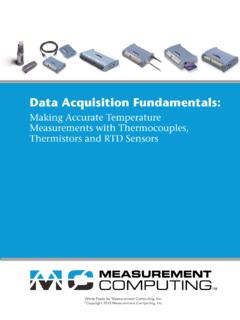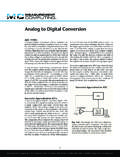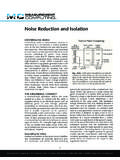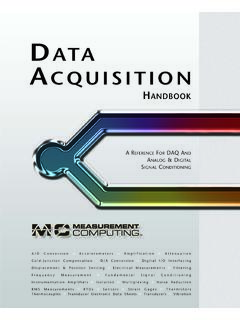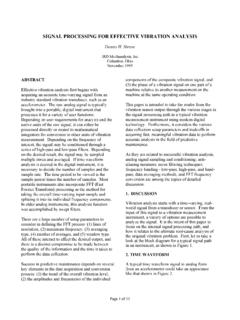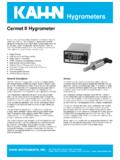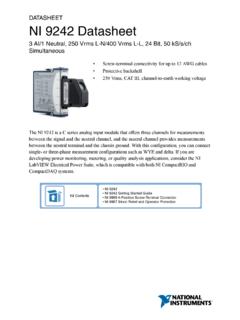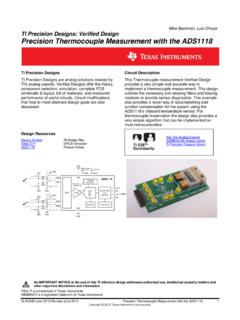Transcription of Fundamental Signal Conditioning - Measurement Computing
1 Measurement Computing 10 Commerce Way Norton, MA 02766 (508) 946-5100 Acquisition Front EndsData acquisition systems differ from single or dual-channel instruments in several ways. They can measure and store data collected from hundreds of channels simultaneously. However, the majority of systems con-tain from eight to 32 channels, typically in multiples of eight. By comparison, a simple voltmeter that can select a Measurement among several different ranges can be considered a data acquisition system, but the need to manually change voltage ranges and a lack of data storage hobbles its illustrates a simple data acquisition sys-tem consisting of a switching network (multiplexer) and an analog-to-digital converter (ADC). The main subject of this chapter, the instrumentation amplifier (IA), is placed between the multiplexer and ADC. The individual circuit blocks each have unique capabilities and limitations, which together define the system performance.
2 The ADC is the last in a series of stages between the analog domain and the digitized Signal path. In any sampled-data system, such as a multiplexed data acquisition system, a sample-and-hold stage preced-ing the ADC is necessary. The ADC cannot digitize a time-varying voltage to the full resolution of the ADC unless the voltage changes relatively slowly with respect to sample rate. Some ADCs have internal sample-and-hold circuits or use architectures that emulate the function of the sample-and-hold stage. The discussion that follows assumes that the ADC block includes a suitable sample-and-hold circuit (either internal or external to the chip) to stabilize the input Signal during the conversion period. The primary parameters concerning ADCs in data acquisition systems are resolution and speed. Data acquisition ADCs typically run from 20 kHz to 1 MHz with resolutions of 16 to 24 bits, and have one of two types of inputs, unipolar or bipolar.
3 The unipolar-type typically ranges from 0V to a positive or negative volt-age such as 5V. The bipolar-type typically ranges from a negative voltage to a positive voltage of the same magnitude. Many data acquisition systems can read bipolar or unipolar voltages to the full resolution of the ADC, which requires a level-shifting stage to let bipolar Figure dataFig. A simple data acquisition system is composed of a multiplexed input stage, followed by an instrumentation amplifier that feeds one accurate and relatively expensive ADC. This arrangement saves the cost of multiple Acquisition Block DiagramFundamental Signal ConditioningFigure + MUXRCFig. The source resistance should be as low as possible to minimize the time constant of the MUX s parasitic capacitance C and series resistance R. An excessively long time constant can adversely affect the circuit s Measurement RC Time Constantsignals use unipolar ADC inputs and vice versa.
4 For example, a typical 16-bit, 100 kHz ADC has an input range of -5V to +5V and a full-scale count of 65,536. Zero volts corresponds to a nominal 32,768 count. If the number 65,536 divides the 10V range, the quotient is an LSB (least significant bit) magnitude of 153 Computing 10 Commerce Way Norton, MA 02766 (508) 946-5100 ARsRiTransducerVsigVADC =VsigRiRs + RiFig. The sensor s source impedance Rs should be relatively small to increase the voltage divider drop across Ri, the amplifier s input. This can substantially improve the Signal -to-noise ratio for mV range sensor and Source ImpedanceMultiplexing through high source impedances does not work well. The reason that low source impedance is necessary in a multiplexed system is easily explained with a simple RC circuit shown in Figure Multiplexers have a small parasitic capacitance from all Signal inputs and outputs to analog common.
5 These small capacitance values affect Measurement accuracy when combined with source resistance and fast sampling rates. A simple RC equivalent circuit consists of a DC voltage source with a series resistance, a switch, and a capacitor. When the switch closes at T = 0, the voltage source charges the capacitor through the resistance. When charging 100 pF through 10 kW, the RC time constant is 1 s. In a 10- s-time interval (of which 2 s is available for settling time), the capacitor only charges to 86% of the value of the Signal , which introduces a major error. But a 1 kW resistor lets the capacitor easily charge to an accurate value in 20 time shows how system input impedance and the trans-ducer s source impedance combine to form a voltage divider, which reduces the voltage read by the ADC. The input imped-ance of most input channels is 1 MW or more, so it s usually not a problem when the source impedance is low.
6 However, some transducers (piezoelectric, for example) have high source impedance and should be used with a special charge amplifier. In addition, multiplexing can greatly reduce a data acquisition system s effective input impedance. The charge injection effects are shown in Figure AmplifiersMany sensors develop extremely low-level output signals. The signals are usually too small for applying directly to low-gain, multiplexed data acquisition system inputs, so some amplifica-tion is necessary. Two common examples of low-level sensors are thermocouples and strain-gage bridges that typically deliver full-scale outputs of less than 50 data acquisition systems use a number of different types of circuits to amplify the Signal before processing. Modern analog circuits intended for these data acquisition systems comprise basic integrated operational amplifiers, which are configured easily to amplify or buffer signals.
7 Integrated operational amplifiers contain many circuit components, but are typically portrayed on schematic diagrams as a simple logical functional block. A few Drive signalMux outputFigure BFig. Analog-switching devices can produce spikes in the MUX output during level transitions in the drive Signal . This is called charge-injection effect and can be minimized with low source Charge Injection EffectsFigure + InvertingNon-InvertingGain = RfRiGain =+1 +RfRiRiRfRiRfAAVinVinVoutVoutFig. The two basic types of operational amplifiers are called inverting and non-inverting. The stage gain equals the ratio between the feedback and input resistor Amplifiers3 Measurement Computing 10 Commerce Way Norton, MA 02766 (508) 946-5100 +Rf 100 kW0 A0 AIoRi 10 kWIF = IiVo = VRLEd = 0 VIiV( ) = V(+) = 0 Vvirtual ground+ Vin = The output polarity of the inverting amplifier is opposite to that of the input voltage.
8 The closed-loop amplifica-tion or gain of this stage is Acl = 10, which is the ratio of Rf/Ri or 100 kW/10 Amplifier Stageexternal resistors and capacitors determine how they function in the system. Their extreme versatility makes them the universal analog building block for Signal operational amplifier stages are called inverting or non-inverting. (See Figure ) A simple equation relating to each configuration provides the idealized circuit gains as a function of the input and feedback resistors and capacitors. Also, special cases of each configuration make up the rest of the Fundamental building blocks, namely the unity-gain follower and the difference Amplifier StagesThe inverter stage is the most basic operational amplifier configuration. It simply accepts an input Signal referenced to common, amplifies it, and inverts the polarity at the output terminals. The open-loop gain of a typical operational amplifier is in the hundreds of thousands.
9 But the idealized amplifier used to derive the transfer function assumes a gain of infinity to simplify its derivation without introducing significant errors in calculating the stage gain. With such a high stage gain, the input voltage sees only the voltage divider composed of Rf and Ri. The negative sign in the transfer function indicates that the output Signal is the inverse polarity of the input. Without deriving the transfer function, the output is calculated from:EQN Inverting AmplifierVo = Vin(Rf/Ri)Where: Vo = output Signal , VVin = input Signal , VRf = feedback resistor, WRi = input resistor, WA +Rf 100 kWIoRi 10 kWIF = IiVo = VRL + Vi0 VIiVin = Vin+RL 10 kWILF igure The input and output polarities of the non-invert-ing amplifier are the same. The gain of the stage is Acl = 11 or (Rf + Ri) Amplifier StageFor example, for a 500 mV input Signal and a desired output of -5V:Vo = Vin(Rf/Ri)Vo/Vin = Rf/Ri5 = Rf/Ri = 10 Therefore, the ratio between input and feedback resistors should be 10, so Rf must be 100 kW when selecting a 10 kW resistor for Ri.
10 (See Figure )The maximum input Signal that the amplifier can handle without damage is usually about 2V less than the supply voltage. For ex-ample, when the supply is 15 VDC, the input Signal should not exceed 13 VDC. This is the single most critical characteristic of the operational amplifier that limits its voltage handling ability. Non-Inverting Amplifier StagesThe non-inverting amplifier is similar to the previous circuit but the phase of the output Signal matches the input. Also, the gain equation simply depends on the voltage divider composed of Rf and Ri. (See Figure )The simplified transfer function is:EQN Non-Inverting AmplifierVo = Vin(Rf + Ri)/RiFor the same 500 mV input Signal , Rf = 100 kW, and Ri = 10 kW:Vo/Vin = (Rf + Ri)/Ri,Vo = Vi(Rf + Ri)/RiVo = (100k + 10 k)/10kVo = (110k/10k) = (11)Vo = Computing 10 Commerce Way Norton, MA 02766 (508) 946-5100 +RfVo =g(V1 - V2)+ V1Rf100 kW+ Feedback gain resistorV2g =RfRiTerminatingresistorFigure resistors100 kW100 kW100 kWRiRiRLOptionalgroundconnectionFig.

